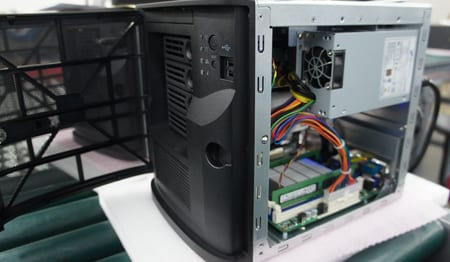General Hardware Recommendations
I’ve built a lot of ZFS storage hardware and have two decades of experience with FreeBSD. The following are some thoughts on hardware.

Intel Versus AMD
FreeNAS is based on FreeBSD. FreeBSD has a long history of working better on Intel than AMD. Things like (but not limited to) the watchdog controllers, USB controllers, and temperature monitoring all have a better chance of being well supported when they are on an Intel platform. This is not to say that AMD platforms won’t work, that there aren’t AMD platforms that work flawlessly with FreeNAS, or even that there aren’t Intel platforms that are poor choices for FreeNAS, but all things being equal, you’ll have better luck with Intel than AMD.
The Intel Avoton platforms are spendy but attractive: ECC support, low power, AES-NI support (a huge boon for encrypted pools). On the desktop side of things, there are Core i3 platforms with ECC support, and of course there are many options in the server arena. The single socket E3 Xeons are popular in the community, and of course for higher end systems, the dual package Xeon platforms are well supported.
Storage Controllers
LSI is the best game in town for add-on storage controllers. Avoid their MegaRAID solutions and stick with their HBAs. You’ll see three generations of HBAs commonly available today. The oldest (and slowest) are the SAS 2008 based I/O controllers such as the 9211 or the very popular IBM M1015. The next generation of these controllers was based on the 2308 which added PCI 3.0 support and increased CPU horsepower on the controller itself. An example here is the 9207. Both the 2008 and 2308 based solutions are 6Gbps SAS parts. The newest generation of controllers are 12Gbps parts such as the 9300. The FreeNAS driver for the 6 Gbps parts is based on version 16 of the stock LSI driver with many enhancements that LSI never incorporated into their driver. In addition, many of the changes after version 16 were specifically targeted at the Integrated RAID functionality that can be flashed onto these cards. As a result, “upgrading” the driver manually to the newer versions found on the LSI website can actually result in downgrading its reliability or performance. I highly recommend running version 16 firmware on these cards. It’s the configuration tested by LSI, and it’s the configuration tested by the FreeNAS developers. Running newer firmware should work, however running older firmware is not recommended or supported as there are known flaws that can occur by running the FreeNAS driver against a controller with an older firmware. FreeNAS will warn you if the firmware on an HBA is incompatible with the driver. Heed this warning or data loss can occur. The newer 12Gbps parts use version 5 of the LSI driver. Cards using this driver should use version 5 of the firmware.
Most motherboards have some number of SATA ports built in. There are certain models of Marvell and J-Micron controllers that are used on motherboards that have large numbers of SATA ports. Some of these controllers have various compatibility issues with FreeNAS, and some of these controllers also have forms of RAID on them. As a general rule, the integrated chipset AHCI SATA ports have no issues when used with FreeNAS, they just tend to be limited to 10 ports (and often far fewer) on most motherboards.
Hard Drives
Desktop drives should be avoided whenever possible. In a desktop, if an I/O fails, all is lost. For this reason, desktop drives will retry I/Os endlessly. In a storage device, you want redundancy at the storage level. If an individual drive fails an I/O, ZFS will retry the I/O on a different drive. The faster that happens, the faster the array will be able to cope with hardware faults. For larger arrays, desktop drives (yes, I’ve seen attempts to built 1PB arrays with ZFS and desktop drives) are simply not usable in many cases. For small to medium size arrays, a number of manufacturers produce a “NAS” hard drive that is rated for arrays of modest size (typically 6-8 drives or so). These drives are worth the additional cost.
At the high end, if you are building an array with SAS controllers and expanders, consider getting the nearline 7200 RPM SAS drives. These drives are a very small premium over Enterprise SATA drives. However, running SATA drives in SAS expanders –while supported– is a less desirable configuration than using SAS end to end due to the difficulty of translating SATA errors across the SAS bus.
Josh Paetzel
iXsystems Director of IT
<< Part 1/4 of A Complete Guide to FreeNAS Hardware Design, Purpose and Best Practices
Part 3/4 of A Complete Guide to FreeNAS Hardware Design, Pools, Performance, and Cache >>
